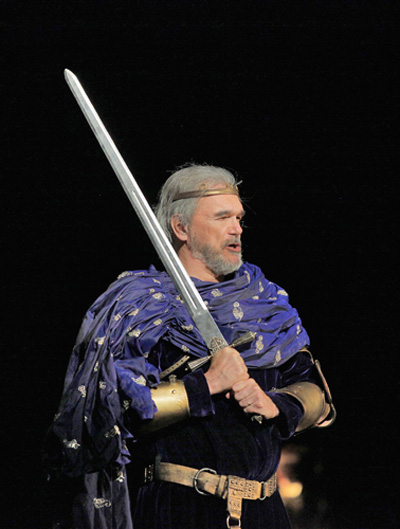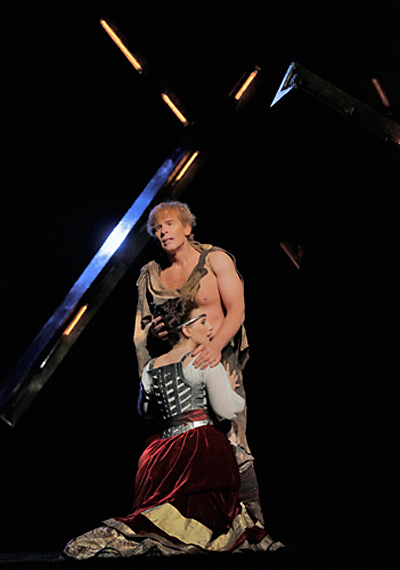|
At seven thousand feet above sea level, which pegs the elevation of Santa Fe, if a reviewer said that an opera production at the Santa Fe Opera made her higher than she had ever been, what exactly would that mean?
WHAT DINOSAUR ANNEX DID FOR LEWIS SPRATLAN'S OPERA
First, a confession. This reviewer had qualms about whether she would enjoy Lewis Spratlan's Life Is a Dream, an opera commissioned in 1975 by the New Haven Opera. During that period of music making, composers typically were creating twelve-tone and dissonant works, a difficult style of music with which this reviewer is not so familiar and which the unschooled generally avoid.
Also, the history of this work gives one pause. Because the New Haven Opera had folded during the three years it took Spratlan and librettist John Maraniss to complete this opera, the work languished until Scott Wheeler, a student of Spratlan's, asked his former professor for a composition to perform in Wheeler's new music forum Dinosaur Annex. Spratlan offered the second act of Life Is a Dream. So in 2000, performances of Act 2 took place at Amherst College and Harvard's Paine Hall. The composer then raised $75,000 to get that segment of the opera recorded and he self-nominated the recording for a Pulitzer, which he won. Then the work went back into obscurity until SFO general director Charles MacKay (MacKay became head of the SFO in 2008) started looking for a work to premiere that was already completed since there was not enough time for a commission.
LIFE IS A DREAM: A LEVITATION
Thus, on August 6, 2010, when the violins, under the masterful direction of Leonard Slatkin, began their eerie shimmer of sound and the menacing but lit pipework began unfolding in front of the very real mountain landscape of Santa Fe that the audience sees as they look at the stage which is open to the majestic view, this reviewer began to levitate with energetic ideas about what was going on in the music and staging of Life Is a Dream. As experienced, the orchestral music comes off as a supporting framework to mood and emotional shaping of a dark story based on Pedro Calderón de la Barca's La Vida es Sueño. Maraniss' libretto, written in English, is alive with elegant poetry and imagery.
What hooked this reviewer immediately were lines like these:
The bird is born, and scarcely
does it don its glittered cloak,
a feathered flower, winged bouquet,
before it splits apart the ethereal halls,
scorning the sheltered nest, while I,
with more soul than a bird, enjoy
less liberty. (Segismundo: Act I, Scene 1)
HOW THE VANQUISED BECAME VICTOR
The story is complicated. Upon the birth of King Basilio's only child, a son named Segismundo (take note of this Germanic name which means "victorious protector"), the King banishes the child to an isolated tower under the guard of Clotaldo, a trusted nobleman who educates the royal offspring but keeps his charge, whom he calls a "prodigy," in chains.
The king tells his court the baby died in childbirth. Why? The child was born at the expense of his mother during an auspicious display from nature that included "the most horrendous eclipse [of the sun] since it mourned the death of Christ," an earthquake with "living fire," a violent storm of hailstones, and blood coloring the rivers. The prediction was that the son would be "the cruelest prince, the most impious monarch of a kingdom made into a school for indulgence, treason and discord" and furthermore he would have the king as "a captive at his feet, [the father's] beard a grey rug that he tread upon."
Yet the father, who is learned but nearing the end of his life, has second thoughts about how he has treated his son and confesses to his court that there is a natural heir to the throne. He orders Clotaldo to drug Segismundo and bring him to the court because if his son misbehaves, then he will be drugged again and returned to his tower prison. The explanation will be that the son only dreamed what happened. Because Segismundo is his father's son, he is smart, but extremely angry. Of course, he behaves badly—he kills a sassy servant by pushing the man off a balcony, attacks Clotaldo and says he will murder his jailor, and amorously tries to rape Rosaura, Clotaldo's out-of-wedlock daughter by his former benefactor.
Back in chains, Segismundo understands more clearly how he is a "monster in a maze." When rebels from King Basilio's court come to fetch him as their new leader—they do not want to be ruled by Astolfo, Basilio's foreign-born nephew— Segismundo refuses to participate because he fears this liberation will also be a dream. In the end, Segismundo comes to his full senses and knows exactly what he must do and how he must behave. He asks for Clotaldo's help and even though Clotaldo says he must remain loyal to Basilio, Segismundo lets the old nobleman go with full understanding. Eventually, Segismundo confronts his father and comes to terms with him.
FLAWLESS ACTING, ANGULAR SINGING
The acting by tenor Roger Honeywell as Segismundo, baritone James Maddalena as Clotaldo, and base-baritone John Cheek as King Basilio was flawless. Segismundo's pain and anguish in the opening act as he emerged in chains from the tower was viscerally felt. Honeywell also made Segismundo's transformation into royal leadership believable and moving.
 |
While King Basilio's explanation to the court was longer than this reviewer thought was necessary (and here the music was set in twelve-tone configuration), Cheek's performance of a father tormented about the tyranny he had imposed on his defenseless child was certainly understandable and moving. What was also memorable about this section of the opera was how appropriate the composer's choice was to write the father's part as a base-baritone which countered the son's tenor part that often stretched into an uncomfortable high range. Overall Clotaldo's fealty to his king, even at the expense of his daughter Rosaura (Ellie Dehn), was engrossing to absorb in the able acting of James Maddalena.
 |
Of course, the acting by these three experienced performers was integral to the singing. However, because the singing was angular in the style of that period of music, this reviewer was less moved by that portion of the performance. Still, when more than one performer sang, there were passages that seemed lyrical and vocally engaging. For example in Act 2 during the court entertainment, a love song, done as a madrigal, unspools that is memorably pretty.
Just because this reviewer has singled out these three performers, it does not mean that she found fault with the rest of the cast. It should also be noted that the production used to good effect five apprentice singers—Thomas Forde (First Soldier/Second Servant), Carin Gilfry (Estrella), Darik Knutsen (First Servant), Heath Huberg (Second Soldier), and Craig Verm (Astolfo)
THE SIDE STORIES
Like a Shakespearean tale, Life Is a Dream has numerous side stories both serious and comic which include Segismundo love for Rosaura (she is the first woman he has ever seen), Clotaldo's discovery that he has a daughter (and first she appears to him as a son in soldier's disguise), Estrella's and Astolfo's aspiration to ascend Basilio's throne, the seduction and betrayal of Rosaura by Astolfo, and the witty and sad portrait of the jester named Clarin (played by Keith Jameson). Because we speakers of English are so atuned to Shakespeare, we often lose sight that Spanish literature has significant masterpieces. Calderón's play La Vida es Sueño is on equal footing for complexity and psychological depth with Miguel de Cervantes El ingenioso hidalgo don Quijote de la Mancha, a novel English-speakers know best as Don Quixote.
THE SHARED RESOURCES OF SPRATLAN'S DREAM OPERA
Spratlan's approach in Life Is a Dream is not unlike cloud computing where the composer allowed the music to form a grid in which resources are shared. Therefore, though the singers seem musically to be on their own, they are still connected to the overall power grid. Perhaps this is like chaos theory where one has to move back to see the bigger picture and understand how things are connected. And to be fair, this musical grid or soundscape also includes a recognizable waltz, march, madrigal and lament.
What happens with the set is clearly inspired by the spikey music and possibly images like "black lightning," which is also the name of a 1970s sci-fi superhero, so there again, the set designer connects into this grid in a way that is different from the usual set design as it incorporates movement and lights and natural landscape. In fact, set designer David Korins and costume designer Jessica Jahn have taken inspiration from a sub-genre of science fiction called steampunk. The spacey-looking pipes that opened and closed into the set throughout the opera look like the Centre Pompidou with its exterior utility pipes miraculously animated.
Clearly the elegant transformation of Segismundo's tower prison into the throne in Basilio's palace is just another instance of resource sharing. Even certain costume elements like the crown of rays that Basilio's niece Estrella wears taps into the energy grid of Spratlan's music and the steampunk theme used primarily for set design.
However , the question lingers about why it took so long for Spratlan's Dream opera to premiere. Despite the Pulitzer Prize, this reviewer wonders if any other company after the Santa Fe Opera's stunning production could possibly do this work justice. On the other hand, this reviewer is eager to hear this music again because she is sure she will hear new things and see more connections between all the parts of this extraordinary opera.
Photos - Ken Howard
|



